![Customer Experience Analysis: How To Measure and Analyze CX [Best Tools Included] cover](https://blog-static.userpilot.com/blog/wp-content/uploads/2022/11/Customer-Experience-Analysis-How-To-Measure-and-Analyze-CX_50c05ad71ad7636fce08405a7779f7ca_2000.png)
Customer Experience Analysis: How To Measure and Analyze CX [Best Tools Included]
Wondering how to collect CX data and conduct a customer experience analysis effectively to boost your product growth?
First and foremost, customer analytics is crucial for making data-driven decisions, since you need to truly understand your customers.
In this article, you’ll learn what customer experience analysis is, why it’s important, how to measure and analyze it using metrics, and how to collect customer data for it.
Ready? Let’s go!
Try Userpilot Now
See Why 1,000+ Teams Choose Userpilot

What is customer experience analysis?
Customer experience analysis is the process of gathering and examining data about your customers to better understand their wishes, opinions, and interactions with your services.
Is Your Customer Experience Analysis Driving Real Impact?
Collecting feedback is useless if you don’t act on it. Are you leveraging customer experience analysis to improve customer engagement effectively? Take this quick assessment to find out.
How do you currently measure the effort required for customers to use your product (CES)?
When a user gives a low NPS score (Detractor), what is your immediate automated action?
Do you use heatmaps or session recordings to analyze friction points?
Turn Insights Into Engagement
Don’t let your CX data gather dust. Userpilot helps you measure sentiment, analyze behavior, and automate personalized in-app responses to improve customer engagement in real-time.
Why should you conduct a customer experience analysis?
Here are three reasons you should immediately conduct a customer experience analysis for your SaaS product.
Understand the drivers of customer behavior
Firstly, it helps you understand customer sentiment.
You can find out why customers are acting in a certain way, which, in turn, allows you to forecast their behavior in the future and enhance their experience, making you better equipped to deal with prospective customers.
Have a better understanding of customer requirements
Secondly, it helps you identify customer needs and determine whether your product fulfills them. So you can see whether you’re on the right path or not.
Identify friction points and areas of improvement
Thirdly, using customer experience analytics, you can identify where your users get stuck the most in your customer journey. These friction points should be fixed quickly as they can significantly increase customer activation and product engagement rate.
Key metrics to measure and analyze customer experience
Here are six valuable CX metrics essential for successful customer analytics that can enhance customers’ experience with your product.
Customer Satisfaction score (CSAT)
The Customer Satisfaction Score (CSAT) measures the degree of user satisfaction with any aspect of your current product and helps you understand user expectations. You may, for instance, use this measure to determine how helpful a customer support session was.
Here’s an example from Hubspot.
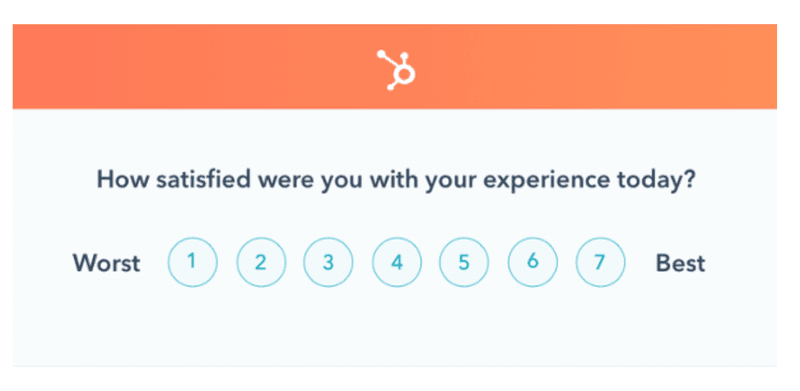
To calculate this, you need to start by conducting a survey where you ask existing customers how they feel about any aspect of your product. Then, the score is calculated by dividing the number of respondents who are highly satisfied by the total number of respondents.
Customer Effort Score (CES)
Customer Effort Score (CES) is a metric that measures how much effort a user has to give to interact with your product. Measuring this metric can lead to fewer customer pain points as you can identify where a user needs help.
For example, when a user uses a feature, you can ask how easy it was to use.
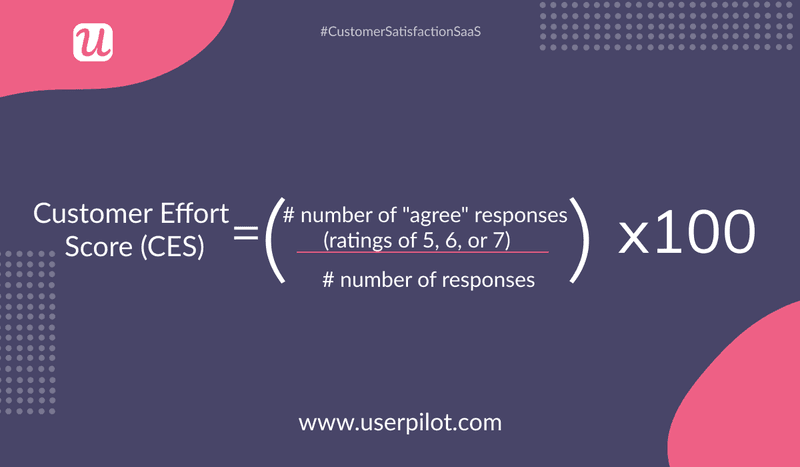
You can calculate CES scores using microsurveys where you ask customers questions such as,”How was your experience with our product today?”
Then, you need to divide the number of responses where users “agree” with you by the total number of survey respondents.
Net Promoter Score (NPS)
The Net Promoter Score (NPS) measures the probability of your customers recommending your product to their close friends, colleagues, or family.
To measure this, you need to conduct a survey where you ask your customers, “How likely are you to recommend us to a friend or family from 1 to 10?”
Your responders are divided into three categories by NPS:
- Promoters are your most loyal customers choosing 9 or 10. They are your brand evangelists and highly engaged customers who will promote your product.
- Neutrals are those who select 7 or 8 are passives. They do not pose any threat.
- Detractors are those who select 6 or lower. They are particularly risky since they might damage your brand’s reputation by spreading negative word-of-mouth.
To calculate NPS, subtract the percentage of detractors from the percentage of promoters, as shown in the image below.
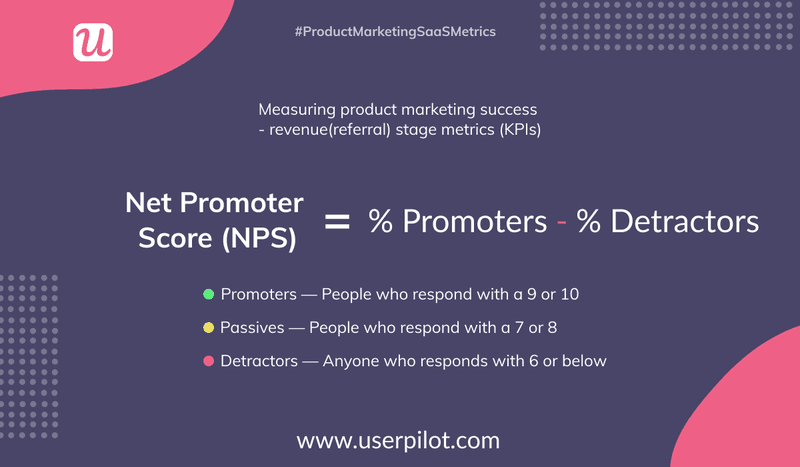
Customer Lifetime Value (CLV)
Customer Lifetime Value (CLV or LTV) is the average revenue a single customer generates for your product throughout their relationship with you. In other words, it is the projection of the future net profit one customer will bring you.
To calculate the CLV, first, you need to determine the average revenue of the account(s) whose total lifetime value you’re trying to assess. Once you’ve determined this value, simply divide it by your present customer churn rate.
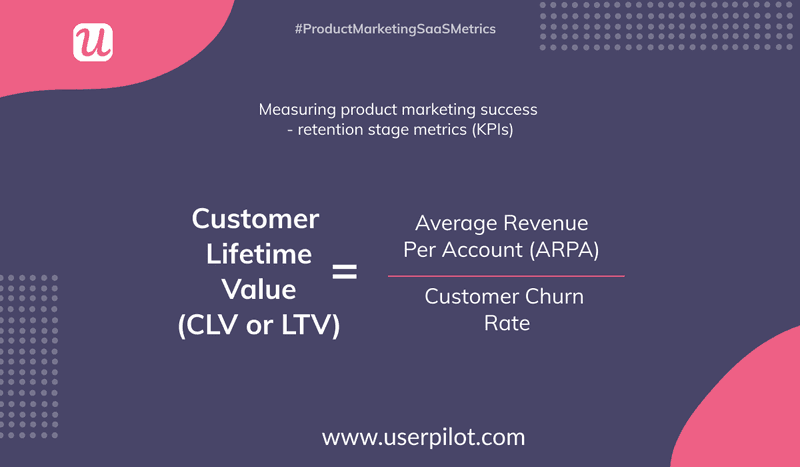
Customer Retention Rate
The customer retention rate measures the percentage of people who continue to use your product over an extended period.
Retention rate can be used to find out how changes in your product affect user satisfaction. For instance, a user might try out an essential feature for a short period and discontinue using your product permanently if they find it to be unusable.
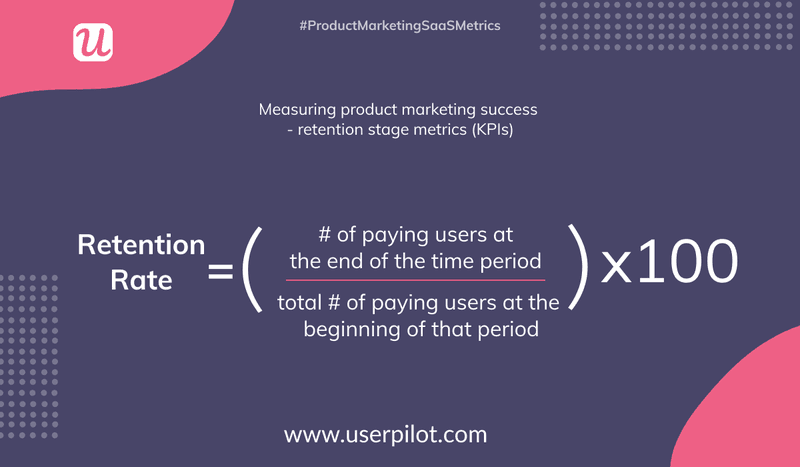
This metric can be calculated by dividing the total number of paying customers at the end of a specified period by the number of paying customers at the start of that period. Your time range can vary between days, weeks, or months.
Customer Churn Rate
The Customer Churn Rate is the percentage of customers who quit your firm over a specific period.
All SaaS companies prefer to minimize customer churn, as a high churn rate can indicate extremely low customer satisfaction. On the other hand, a low churn rate indicates that your products exceed expectations. Your users are highly satisfied and are likely to be long-term customers.
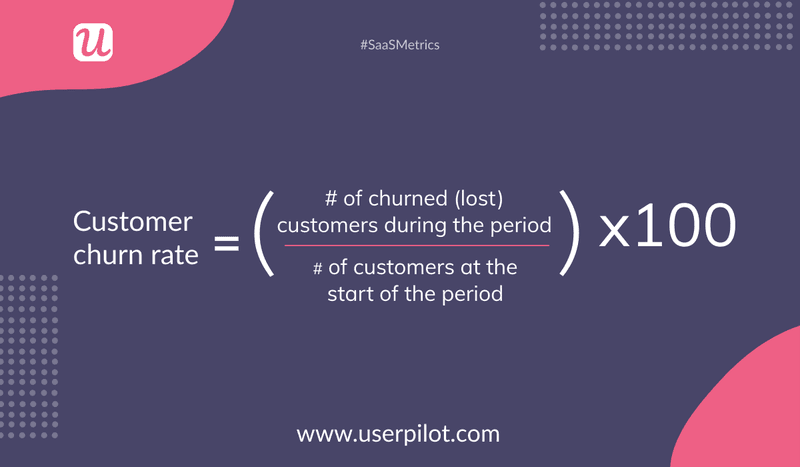
For a specified timeframe, you can calculate the customer churn rate using the formula above. But first, you need to find out the total number of customers at the beginning of that period and the number of lost customers during the period.
Customer experience analysis: Different sources to capture customer data
Now that you know what to measure, here are six different sources you can use to collect all the data you need for a successful customer experience analysis.
Map out the key touchpoints in the entire customer journey
Before you start collecting CX data, you must identify the key touchpoints where your customers interact with your products and map out the entire customer journey.
Customer touchpoints are all customer interactions with your brand, such as reading articles on your website, leaving reviews, engaging with ads, contacting the support team, interacting with a core feature, filling out a microsurvey, etc.
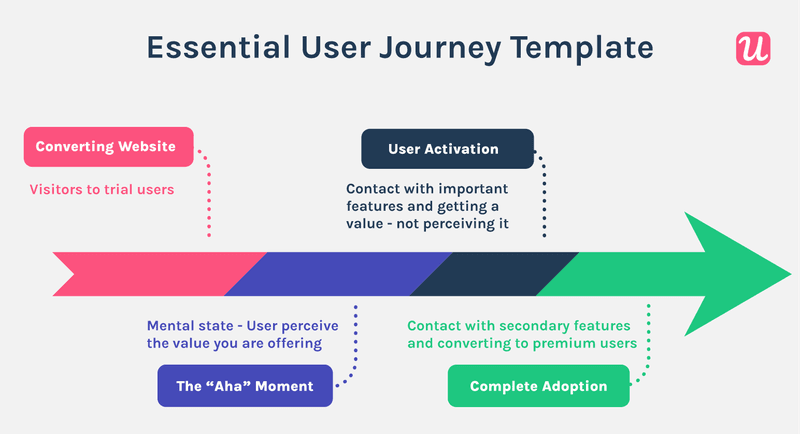
Leveraging these points allows you to measure customer satisfaction and detect friction points, such as product bugs or poor customer experience, early on. This allows you to create a smoother user journey that can improve customer engagement and experience and thus deliver greater revenue.
Track in-app feature usage and other customer interactions
When it comes to collecting customer feedback effectively, tracking customer interactions and feature usage remain one of the best ways to get actionable insights.
By tagging your features, you can discover which features customers interact with the most and least. This helps you decide whether to improve existing features, introduce new ones, or remove old ones.
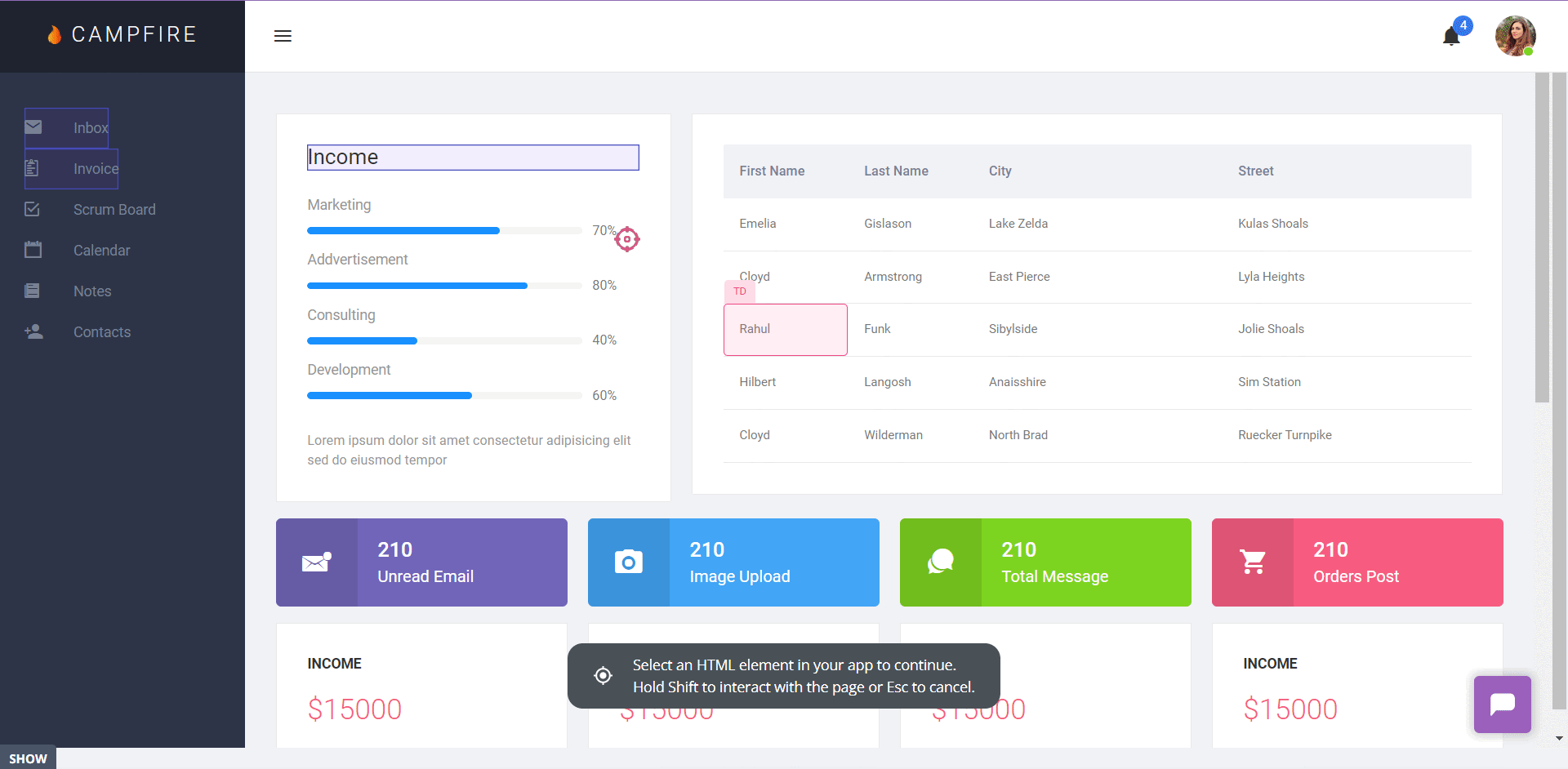
Userpilot features a very easy-to-use feature usage tracker. With this, you can track not only your features but also several other interactions, such as clicks, hovers, and text inputs, to have more actionable data.
Use heatmaps to pinpoint areas that impact the customer experience
Heatmap is a color-coded visualization of customer interaction that helps you identify high and low engagement areas.
With it, you can see customers’ clicks, scrolls, and taps. This provides a clear way to identify your product’s most popular parts.
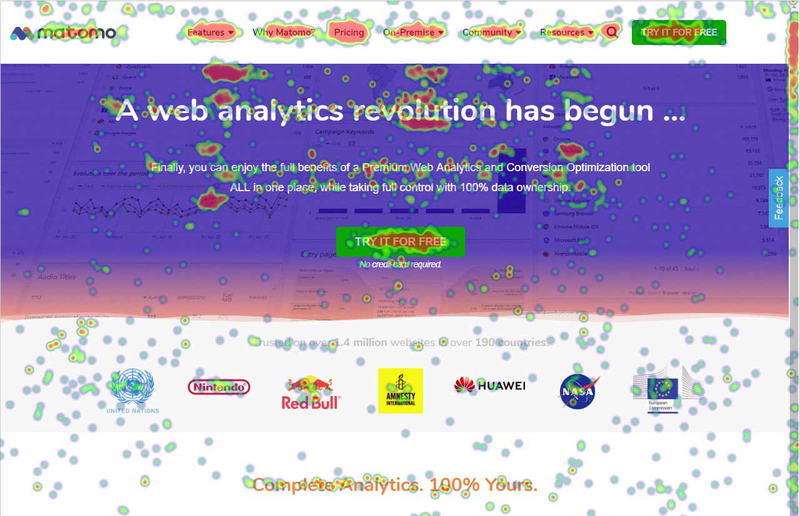
Usually, the color of the maps varies depending on the analytics tools you use. In the example above, the red colors describe hot areas with high user interaction, yellow represents medium interaction, and blue represents cold areas with the least interaction.
Send CSAT surveys after key interactions to measure customer satisfaction
CSAT surveys are very helpful when you’re looking to address customer pain points and improve customer satisfaction.
Here’s an example from Hellosign.
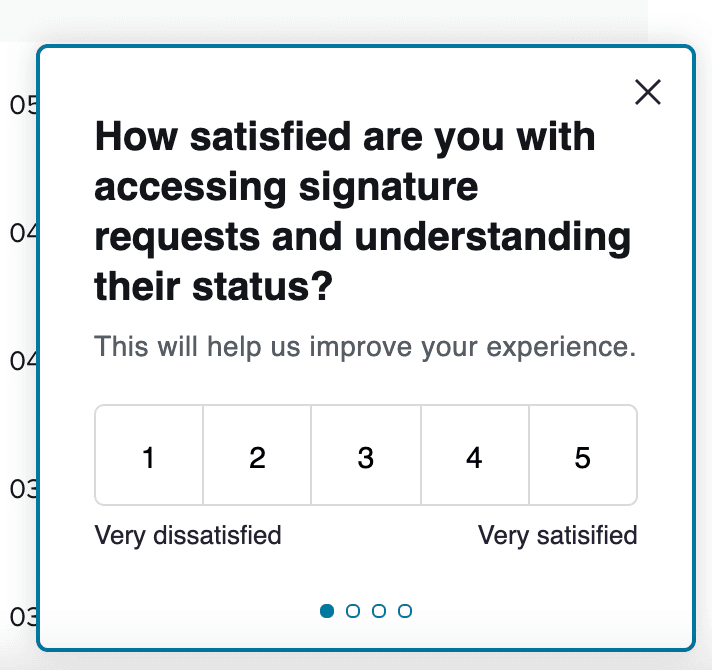
To make the most out of CSAT surveys, you need to measure customer interactions at the right time. For example, you can send these surveys after these key interactions:
- initial onboarding
- customer support sessions
- interaction with a new or core feature
- a free trial is over
- account upgrade
This helps you collect customer data across different touchpoints and improve the quality of all your data.
Use NPS surveys to collect customer feedback and identify friction points
Conducting NPS surveys is a great way to collect data on your customers and measure their loyalty. But did you know that there’s one way to make them even more powerful for CX analysis?
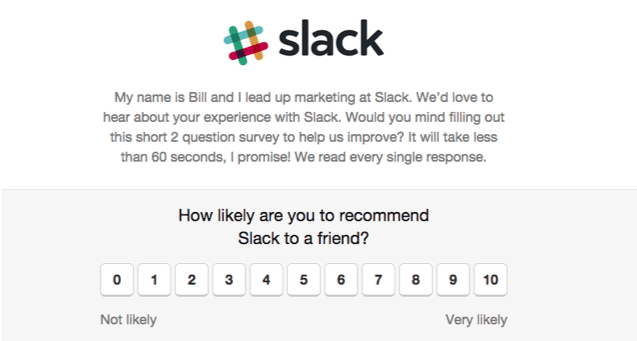
Immediately after users select a score, you can prompt them with a follow-up qualitative question. This allows them to explain their given score and help you identify unique or repetitive issues.
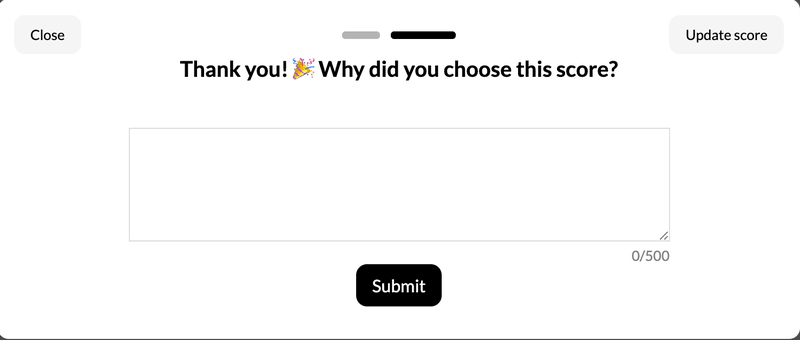
Understanding why your customers might or might not recommend your product to others is one of the keys to improving customer engagement.
Implement the Voice of the customer (VoC) program and make customers heard
One way to get high-quality customer feedback is by directly interviewing your product’s users through the Voice of the Customer (VoC) program.
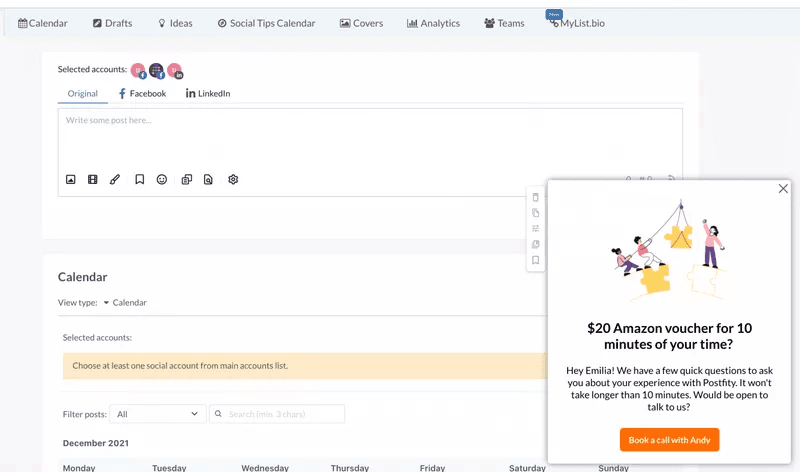
Using this, you can get invaluable information about different customer segments and get a deeper understanding of your users.
You can provide different incentives, such as coupons and flat discounts, to encourage user participation. When your users feel heard, they feel more important, which improves your relationship with current customers.
How to analyze customer experience data?
Here are three ways you can analyze the collected data and improve customer experience.
Tag and categorize qualitative feedback data to identify trends
Remember using the follow-up qualitative question in your NPS survey?
With Userpilot, you can tag those responses and analyze them in depth, which allows you to categorize the feedback and identify trends.
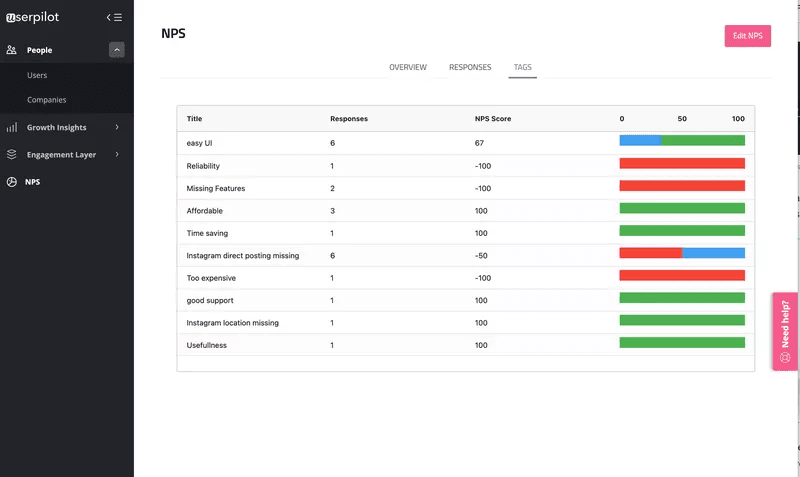
Response tagging allows you to detect trends between the most common issues and see how it affects the overall customer experience. This also helps you identify the weakest aspects of your product that demand urgent attention.
For example, in the image above, product reliability, missing features, and price are the most common issues faced by customers.
Segment customers based on shared experience and characteristics
Customer segmentation enables you to classify users into groups that share similar experiences and characteristics. But how to do it properly?
Userpilot’s advanced segmentation allows you to segment customers by different attributes, such as content engagement, user profiles, user feedback, features, and events.
When you create defined segments, you have a deep understanding of your user base. With that being said, you can also identify your power users, regular users, and inactive users who are at risk of churning.
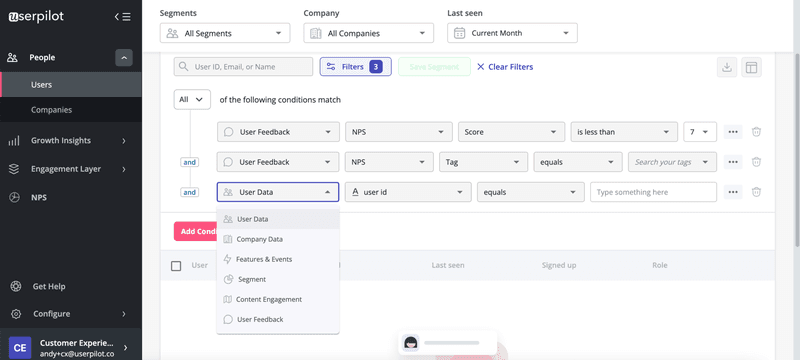
Segmentation allows you to understand and appreciate the different behaviors of your customers, which allows you to create personalized in-app experiences for them and improve their overall experience and relationship with your brand.
Build funnels to see where customers are dropping off
A user funnel depicts the customer’s journey from first learning about your product to eventually purchasing it and promoting it. It includes all of the key touchpoints that customers must experience.
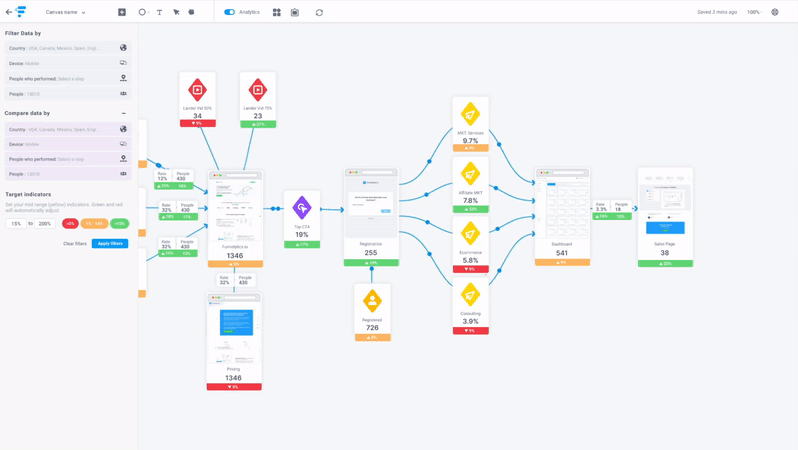
A user funnel helps you visualize all the user interactions and see where customers are dropping off the most. By incorporating a user funnel into your SaaS product, you can discover areas of friction that need improvement and make data-driven decisions to increase conversion rates.
Best customer experience analysis tools for SaaS companies
Here are the three best customer experience analysis tools for SaaS companies that help you with the entire process of CX analytics, from collecting data to visualizing the results.
Userpilot
Userpilot is currently one of the best tools in the market for CX analytics. It has a lot of intelligent features, including feature tracking, advanced customer segmentation, and an in-app interaction tracker.
It is equipped with various microsurvey templates, so you can easily launch CSAT and NPS surveys that help you evaluate customer interactions and understand the overall CX scenario of your product.
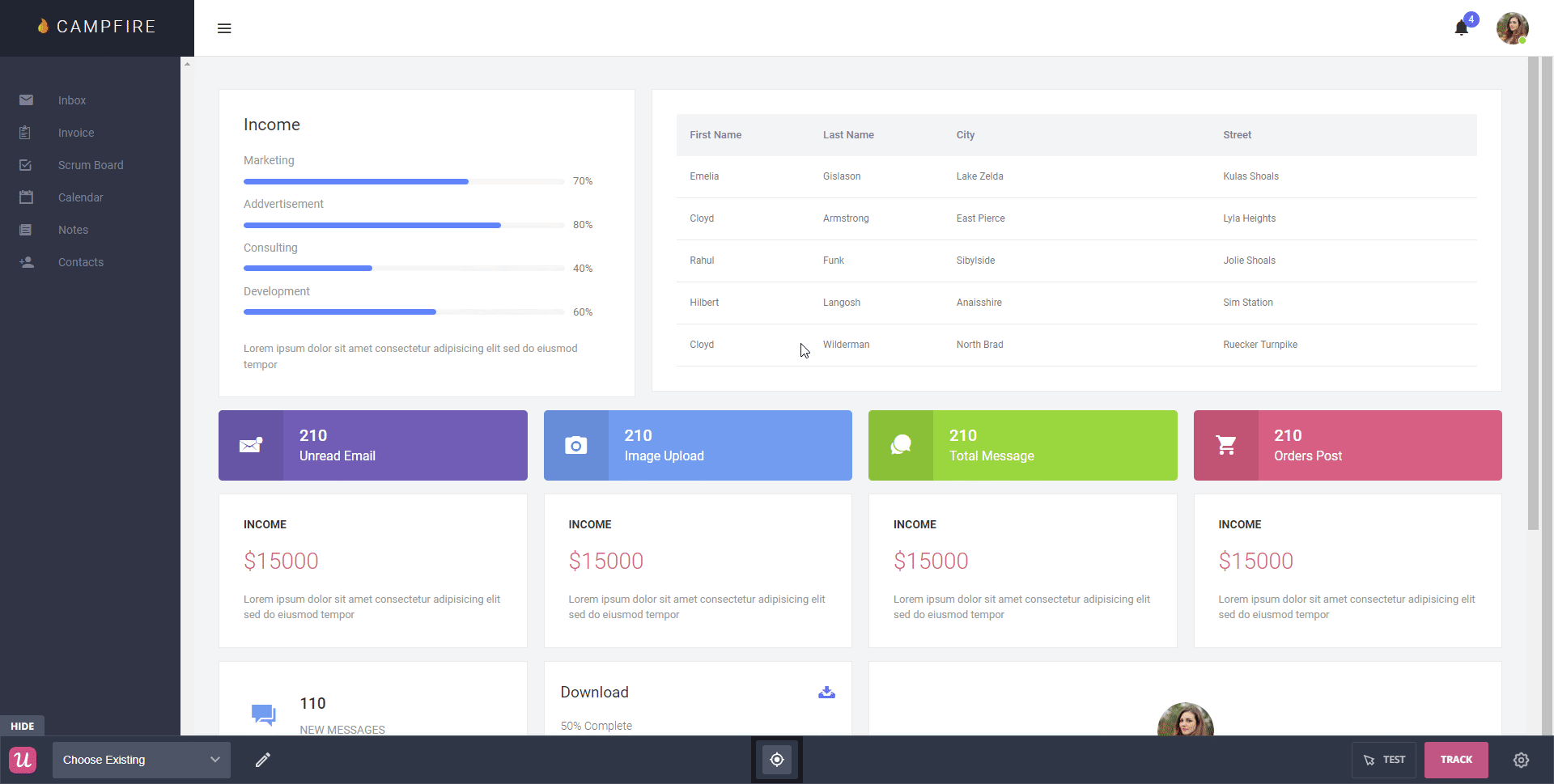
You can customize and launch in-app surveys of different types with Userpilot to gain insights into the mobile app experience.
It also has real-time analytics that helps you understand the impact of your decisions live, enabling you to take quick actions using CX data.
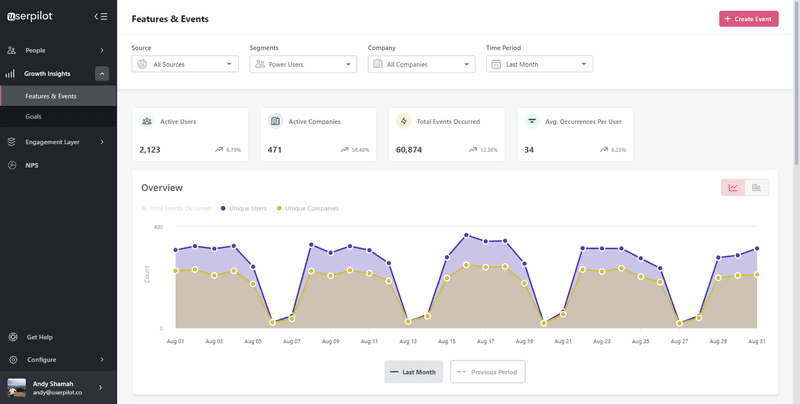
With Userpilot, you can also create flows based on custom settings and event occurrences. You can trigger in-app experiences in real time that help you increase engagement with different users.
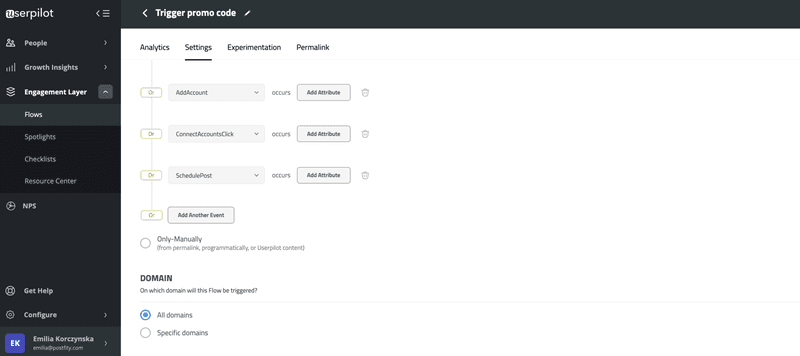
You can choose from 3 different Userpilot subscription packages:
- $299 for Starter(billed annually).
- Custom pricing for the Growth package.
- Custom pricing for the Enterprise package
Feel free to sign up for a demo if you’d like to give it a shot!
Hotjar
Hotjar is a CX analytics tool that has two major functions: Observe and Ask.
Observe features heatmaps and session recordings. With heatmaps, you can see what elements attract users the most and what elements get ignored the most.
Session recordings allow you to see exactly what your users see, allowing you to map the full user journey in detail. You can also use numerous filters to sort your data and find churning customers and repeat customers.
Ask helps you collect live feedback with context, which helps you understand what users think about your product. Using on-site and external surveys, you can send surveys to users whenever required and gain as much data as possible.
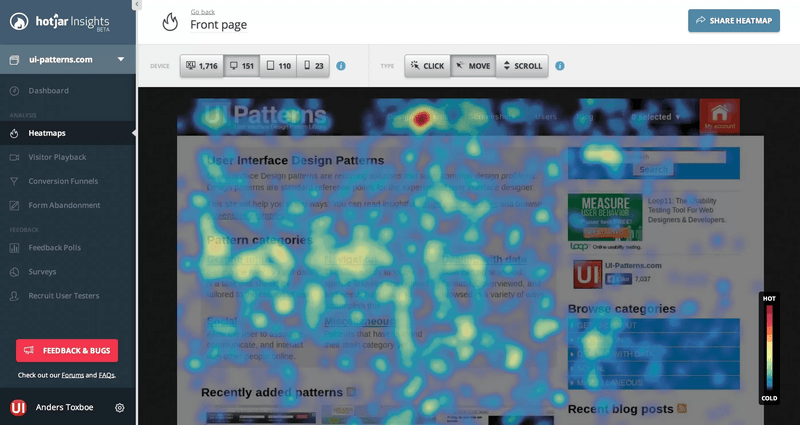
Observe has three different monthly packages starting from $0, $39, and $99. Ask also has three packages starting from $0, $59, and $79. Both options include a custom plan upon request and a free trial.
Additionally, you can choose a custom package that combines both Observe and Ask.
Mixpanel
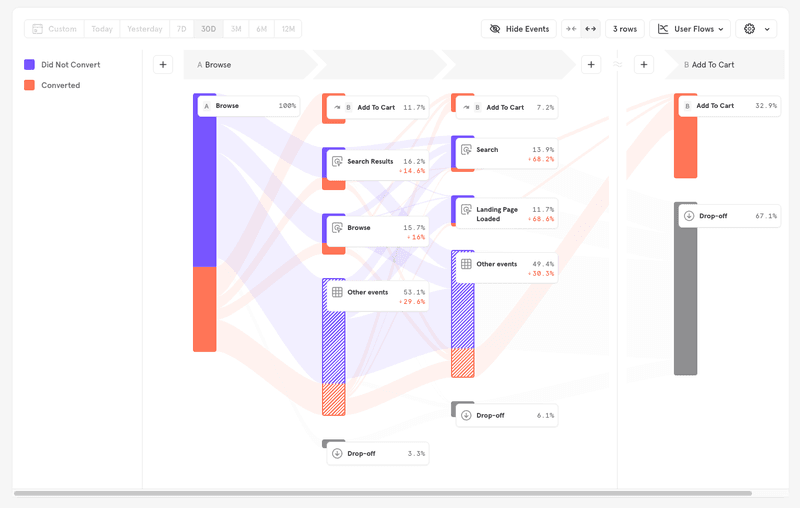
Mixpanel is a powerful product analytics platform that helps you convert, engage, and retain users through interactive insights, retention, and funnel reports.
It also features team dashboards and alerts, limitless segmentation, group analytics, data integration, data management, etc. With all these, you get insights into your product usage, as well as where and why users drop off, and who your best customers are.
It has three subscription plans:
- Free
- Growth (from $25 per month)
- Enterprise
Conclusion
Simply collecting customer data is not enough to grow your business anymore. To ensure that your customers keep making purchases from you, you must actively manage your customer relationships.
Regardless of your goal – customer retention, higher CLV, or enhanced advocacy, customer experience analytics helps you uncover the logic behind customer interactions so you can create better product experiences.
Want to collect in-app data and conduct a customer experience analysis? Get a Userpilot Demo and see how you can do it code-free and build stronger customer relationships.





